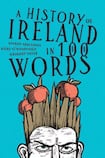
The late Ciaran Carson cheekily entitled one of his collections, The Irish for No. The joke was that in modern Irish there is no word for no. Nor for that matter, is there a word for yes. The Tá that appeared on button badges worn by supporters of a yes vote in the marriage equality referendum does not mean Yes but ‘it is”. But now this fascinating new volume reveals that there was indeed historically an Irish word for no, Náthó and an Irish word for yes, Tó (confusingly no relation to Tá). Three leading Celtic Studies scholars, Sharon Arbuthnot, Máire Ní Mhaonaigh and Gregory Toner have combined to produce a word hoard that through an English-language commentary on 100 Irish-language words deftly takes in the many faceted history of life on the island of Ireland. They are assisted in this task by the impish, illustrative bravura of Joseph McLaren. Their approach to culture is anthropological in the broad sense, taking in all aspects of a lived life, rather than culture in the narrower, aesthetic sense. There are words relaying to science and technology, food and feasting, trade and social status, health and the body.
The modern Irish word for computer, for example, ríomhaire relates to rímaire, a person rather than a thing, who was responsible for observing the movements of the heavens and who was skilled in the new science of computistics brought by Christian missionaries to medieval Ireland. The word has a contemporary application but the echo-chamber of etymology leads us back over a thousand years to the educational formation of a young scholar. The simple task of daily ablutions was both more specific and complex in early Irish with up to 14 words for different kinds of washing, the washing of hair (folcaid) was not the same as the washing of hands or feet (indlaid) which was different from the more general word (nigid) which could refer to washing any part of the body or washing clothes.
As the authors point out, “It is no longer thought that people’s perception of the world is limited by their vocabulary, but our store of words does say something fundamental about us and how we think”. The point is not to endlessly recite a story of former greatness but to give a vivid insight into the worldviews and value systems of the populations who have inhabited the island down through the centuries and who chose to communicate that experience in Irish. Part of that experience was encountering others who were not from the island. A History of Ireland in a 100 Words is generous in acknowledging the debt to translation from other languages and the multiple borrowings that took on their own life in the language. Rince is a common word for dance in Irish but the authors argue it is a probably a form of ranc taken from French ranc or English rank.
Rinnce fada
When in 1699 the poet Domhnall Garbh Ó Súilleabháin describes a party at an Irish nobleman’s house, the word rince is paired with other words to capture the heady variety of the night’s entertainments, a rinnce an chlaidhimh (a sword dance), a rinnce an ghadairigh (a withy dance), a rinnce treasach (a ranked dance, involving several changes) and a rinnce fada (long dance).
The source of insipiration for the present volume is the electronic Dictionary of the Irish Language, a digited, updated version of the Royal Irish Academy’s Contributions to the dictionary of the Irish language. The aim is to make the formidable scholarship of the enterprise available to a wider public. “From around the sixth century, Ireland began to develop what became the most extensive surviving vernacular literature in early medieval Europe.” Indeed, it was the discovery of that legacy that would provide imaginative energies for the political and cultural revivals at the turn of the 20th century, feeding into everything from the foundation of the Gaelic Athletic Assoication to the composition of Finnegans Wake. Yet, if I was a modern day visitor to the city of Dublin or Cork or Galway or Belfast where would I find the museums or interpretive centres that would give me some idea of the importance of this “extensive surviving vernacular literature”?
Outside of the temples of scholarship and the gatherings of specialists, where I would take a group of curious schoolchildren who wanted to know more about the immensity of that inheritance? These absences have deeper implications. One of the striking features of the early literature is the relationship to the natural world and the shaping of the Irish landscape. Any viable approach to future sustainability on the island involves an urgent reconnection to lost ecological sensibilities, to a culturally meaningful engagement with the skies and lands and seas around us that are glimpsed in this work. Perhaps, a better title for this engaging, informative and illuminating volume would be A Future for Ireland in 100 Words.
Michael Cronin is director of the Trinity Centre for Literary and Cultural Translation. He is the author of Irish and Ecology/An Ghaeilge agus an Éiceolaíocht (2019)










